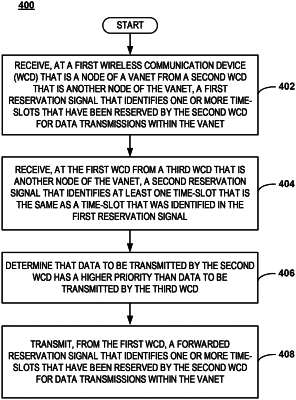| CPC H04W 28/26 (2013.01) [H04W 4/46 (2018.02); H04W 72/20 (2023.01); H04W 72/0446 (2013.01); H04W 84/042 (2013.01); H04W 84/18 (2013.01)] | 18 Claims |

|
1. A method comprising:
receiving, at a first wireless communication device that is a node of a vehicle ad-hoc network (VANET) from a second wireless communication device that is another node of the VANET, a first reservation signal that identifies one or more time-slots that have been reserved by the second wireless communication device for data transmissions within the VANET;
receiving, at the first wireless communication device from a third wireless communication device that is another node of the VANET, a second reservation signal that identifies at least one time-slot that is the same as a time-slot that was identified in the first reservation signal;
determining that data to be transmitted by the second wireless communication device has a higher priority than data to be transmitted by the third wireless communication device; and
transmitting, from the first wireless communication device, a forwarded reservation signal that identifies the one or more time-slots that have been reserved by the second wireless communication device for data transmissions within the VANET, the forwarded reservation signal based, at least partially, on the first reservation signal and containing information upon which one or more additional wireless communication devices may determine whether to transmit data within the one or more time-slots identified in the forwarded reservation signal.
|